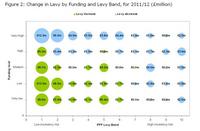The Pension Protection Fund (PPF) accepts its new levy calculation will mean increased charges for schemes with low insolvency risk, except when they are in the highest funding brackets
The key change for schemes announced today for the 2012/2013 levy is the resetting of the balance between solvency and funding, aimed at reducing investment risk and encouraging higher funding levels.
The PPF has also released details about the addition of investment risk into the calculation, with stress tests weighted against volatile assets, and a revised 10-band charging system, increased from the proposed six to reduce charging "cliff-edges" for schemes.
For the first time, schemes which invest in more risky assets will be penalised by higher levy payments. Those with higher allocations to equities and commodities will see their levy payments increased, while those with higher allocations to index-linked bonds, annuities and gilts will be see their levy dropped.
But Alan Rubenstein, the PPF's chief executive, emphasised the organisation was not seeking to influence schemes' investment decisions.
The PPF also stressed there would be no requirements on schemes to submit additional investment data. However, it began to collect the monthly failure score, which measures the employer's risk of insolvency, in April. Some schemes are already monitoring this score regularly.
The impact of the change on 2011/2012 figures, taken from page 11 of the PFF's policy document, would mean levy decreases (in blue) for those with high insolvency risk, on the right-hand side of the graph below, and increases (in green) for those with low insolvency risk, on the left-hand side, across the majority of the funding levels.
"The impact of this, all things being equal, will be that schemes with the top 40% of funding levels will see their levies go down, or remain flat," said Alan Rubenstein, chief executive.
"Even if you are a highly-rated scheme, if your funding level is low or very low – the bottom 40% – you will see your levy increase."
This is part of a two-pronged move, said Rubenstein, to adequately mirror PPF-relevant risks on funding and investment strategy.
"What we are trying to do is fairly reflect the risks to the PPF and charge appropriately," he said. "No more than that."
The pensions lifeboat will calculate investment risk based on data which are currently reported to the Pension Regulator's Exchange system.
The PPF claimed it was not “seeking to influence” trustees, but Chris Atkin, founder of actuaries Atkin and Co, questioned this, given the policy document confirmed it will stress test scheme assets with, for example, a 22% drop in UK equities.
“They are going to influence behaviour,” Atkin said. “If you are going to give credit for investing in bonds, and debit for investing in equities, yes you are going to have some influence on behaviour.”
Vernon Holgate, director of Capital Cranfield, said he thought the PPF's shift was focused on larger schemes where adverse investment risk-taking would have serious consequences for the PPF.
"Of course if the detail of this in its application led to everyone switching into index linked gilts, then there will be more accidents for the PPF to clear up," he said. "However, I doubt that this will be the case."

Shifting expectations
Last week, the PPF changed the assumptions underlying its s179 and s143 valuations – lifting the longevity estimates for males.
Increasing prices in the bulk annuity market led it to reduce the effective yields used to discount future payments by 0.2% a year for compensation in payment.
This wiped £34.9bn off the fund surplus, bringing it to £2.3bn, which is now just 0.2% above fully funded.
Laith Khalaf, a pensions analyst at Hargreaves Lansdown, said the shift would mean an increased levy payment across all schemes.
“That calculation basis is also used for calculating the levies that schemes have to pay,” he said.
The PPF’s assumption that men will live longer increases the calculation of its liabilities as it works out how much compensation it will need to pay to members.
Khalaf said: “That would feed through into higher PPF levies for schemes, other things being equal.”
Schemes should already be making similar changes to their mortality expectations, he said, which will be different for a membership made of largely manual workers to one made up of office workers, for instance.
“All we are trying to do is make sure we have the ability to meet our obligations to pay members,” said a PPF spokesperson.
“The best way is to make sure that when we are valuing schemes we are in line with the market; otherwise it would be out of kilter."






















